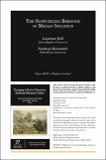Artículo
The nonpuzzling behavior of median inflation
Date
2020Abstract
For decades, textbooks have explained inflation behavior with
Friedman (1968)’s Phillips curve: the inflation rate depends on
expected inflation and the deviation of unemployment from its natural
rate. Yet this theory has always been controversial, and skepticism
has been rampant in the decade since the 2008 financial crisis. For
several years following the crisis, researchers such as Stock (2011) and
Coibion and Gorodnichenko (2015) puzzled over a “missing deflation:”
inflation did not fall much despite a sharp rise in the unemployment
rate. More recently, as the economy has approached full employment,
economists have puzzled over the failure of inflation to rise toward the
Federal Reserve’s target of 2 percent. According to Bernstein (2017),
recent low inflation is “puzzle #1 in economics.”
Collections
View/

The following license files are associated with this item:

